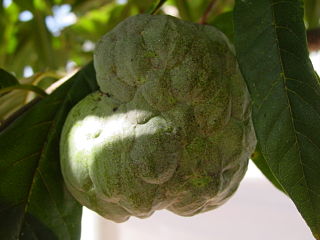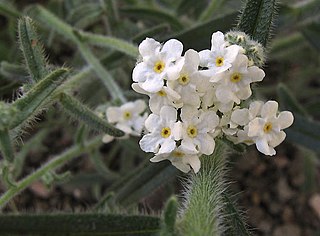
Correa is a genus of flowering plants in the family Rutaceae, with bell-shaped flowers, native mainly to eastern Australia. There are ca. 11 species in the genus and 26 subspecies. Natural hybridisation between the species makes taxonomic relationships within this genus problematic. There are also hundreds of named cultivars, many of which have been registered with the Australian Cultivar Registration Authority.

Prosopis is a genus of flowering plants in the pea family, Fabaceae. It contains around 45 species of spiny trees and shrubs found in subtropical and tropical regions of the Americas, Africa, Western Asia, and South Asia. They often thrive in arid soil and are resistant to drought, on occasion developing extremely deep root systems. Their wood is usually hard, dense and durable. Their fruits are pods and may contain large amounts of sugar. The generic name means "burdock" in late Latin and originated in the Greek language.

Bauhinia is a genus of more than 500 species of flowering plants in the subfamily Cercidoideae and tribe Bauhinieae, in the large flowering plant family Fabaceae, with a pantropical distribution. The genus was named after the Bauhin brothers Gaspard and Johann, Swiss-French botanists.

Soursop is the fruit of Annona muricata, a broadleaf, flowering, evergreen tree. The exact origin is unknown; it is native to the tropical regions of the Americas and the Caribbean and is widely propagated. It is in the same genus, Annona, as cherimoya and is in the Annonaceae family.

The Annonaceae are a family of flowering plants consisting of trees, shrubs, or rarely lianas commonly known as the custard apple family or soursop family. With 108 accepted genera and about 2400 known species, it is the largest family in the Magnoliales. Several genera produce edible fruit, most notably Annona, Anonidium, Asimina, Rollinia, and Uvaria. Its type genus is Annona. The family is concentrated in the tropics, with few species found in temperate regions. About 900 species are Neotropical, 450 are Afrotropical, and the remaining are Indomalayan.

Cryptantha is a genus of flowering plants in the borage family, Boraginaceae. They are known commonly as cat's eyes and popcorn flowers. They are distributed throughout western North America and western South America, but they are absent from the regions in between.

Leucas is a genus of plants in the family Lamiaceae, first described by Robert Brown in 1810. It contains over 200 species, widespread over much of Africa, and southern and eastern Asia with a few species in Queensland and on various islands in the Indian Ocean.

Senna, the sennas, is a large genus of flowering plants in the legume family Fabaceae, and the subfamily Caesalpinioideae and the tribe Cassieae. This diverse genus is native throughout the tropics, with a small number of species in temperate regions. The number of species is estimated to be from about 260 to 350. The type species for the genus is Senna alexandrina. About 50 species of Senna are known in cultivation.

Calochortus nuttallii — known as sego lily — is a bulbous perennial which is endemic to the Western United States.

Piptadenia is a genus of tropical shrubs and trees of the legume family.

Albizia inundata is a perennial tree native to South America. Common names include maloxo, muqum, paloflojo, Timbo Blanco, Timbo-ata, and also "canafistula" though this usually is Golden Shower Tree.

Echinochloa muricata is a species of grass known by the common names rough barnyard grass and American barnyard grass. It is native to Eurasia and much of North America.

Hebe stricta, commonly called koromiko, is a plant of the family Plantaginaceae, which is endemic to New Zealand. Recently Hebe stricta has been reclassified and the botanical name has changed to Veronica stricta.

Adesmia is a genus of flowering plants in the legume family, Fabaceae. It was recently assigned to the informal monophyletic Adesmia clade within the Dalbergieae.

Chaetocalyx is a genus of lianas in the legume family, Fabaceae. It belongs to the subfamily Faboideae, and was recently assigned to the informal monophyletic Adesmia clade of the Dalbergieae. Members of this genus are found in Central and South America. Chaetocalyx can be distinguished from most other legumes by its climbing habit, its imparipinnate leaves, and, in most species, by its elongate loments. It can be distinguished from Nissolia, which also has a climbing habit, by the articles of the loments, which are uniform in size in Chaetocalyx, rather than with a terminal, expanded, winglike article as in Nissolia. Unlike most papilionoid legumes, Chaetocalyx species do not form root nodules.

Trophonopsis muricata is a species of sea snail, a marine gastropod mollusk in the family Muricidae, the murex snails or rock snails.

Tupistra is a genus of about 20 species of flowering plants found in south Asia, from southern China to Sumatra and Ambon Island. In the APG III classification system, it is placed in the family Asparagaceae, subfamily Nolinoideae.
Isoetes echinospora, also known as spiny quillwort, spiny-spored quillwort or spring quillwort is a species of quillwort in the Isoetaceae family, and is the most abundant species in Canada. It can be found in shallow aquatic environments from Labrador and Newfoundland to Alaska, and south to Pennsylvania, Wisconsin, Colorado, and California. In Germany it is found in only 2 locations: the Feldsee and Lake Titisee, both in the High Black Forest. It bears 10-30 green to yellow leaves and a two-lobed corm. The velum covers one to three quarters of the sporangium, which are 10 millimeters long. Round white megaspores are about 480 micrometers in diameter and are covered with spines. Kidney-shaped microspores are about 26 micrometers long with smooth, fine spines. European populations of the plant lack stomata, which are present in North American populations. Isoetes muricata and Isoetes echinospora var. braunii refer to the North American plants when they are considered to be distinct from the European plants.
The Flora of Fuegia, the Falkland Islands, etc. is a description of the plants discovered in these islands during the Ross expedition written by Joseph Dalton Hooker and published by Reeve Brothers in London between 1845 and 1847. Hooker sailed on HMS Erebus as assistant surgeon. It was the second in a series of four Floras in the Flora Antarctica, the others being the Flora of Lord Auckland and Campbell's Islands (1843-1845), the Flora Novae-Zelandiae (1851–53), and the Flora Tasmaniae (1853–59). They were "splendidly" illustrated by Walter Hood Fitch.
Ira Waddell Clokey (1878-1950) was an American mining engineer and botanist active in the western United States. He first studied at the University of Illinois, then moved to Harvard University, graduating with a Bachelor of Science in mining engineering in 1903. From 1904 to 1915, Clokey worked as a mining engineer in Mexico. In his spare time he collected plant specimens for his personal herbarium, which, however, was almost completely destroyed during a fire in 1912. In 1921, Clokey completed a Master of Science in plant pathology from Iowa State University.
















